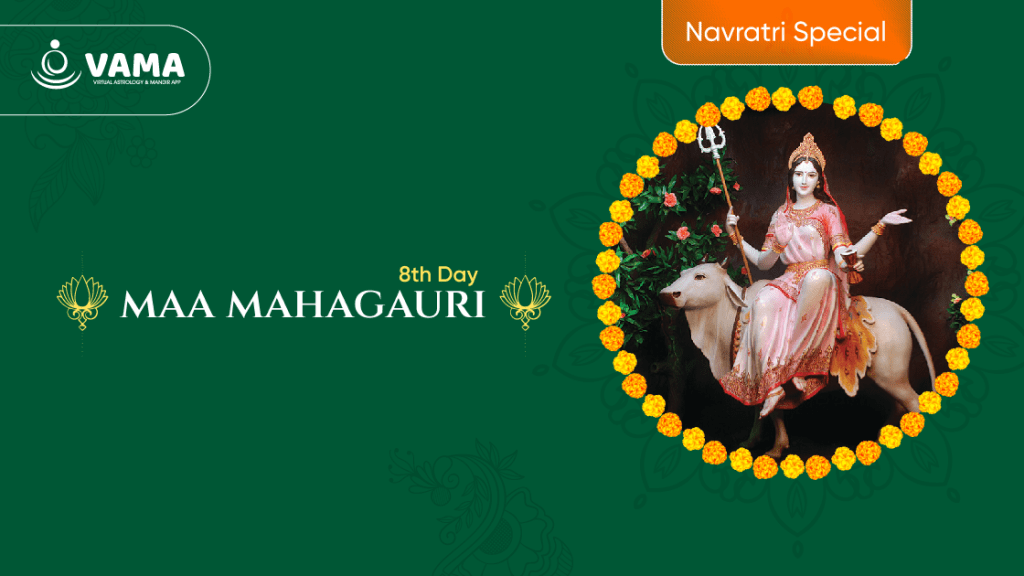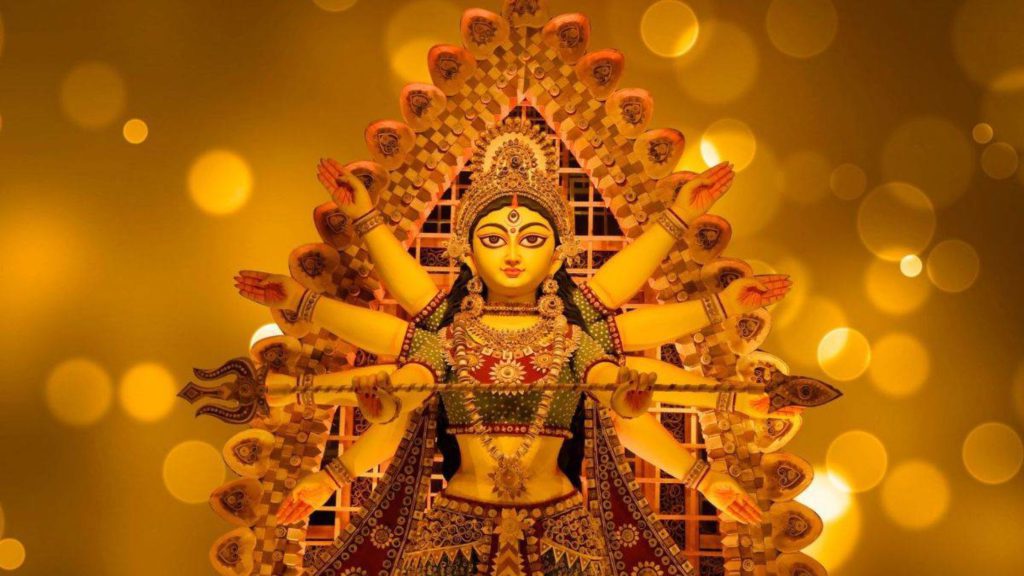The Significance of Maa Mahagauri and Ashtami Rituals
Today, as we embark on the eighth day of Navratri on 22nd October, 2023, we immerse ourselves in the serene presence of Maa Mahagauri, the goddess of purity and divine prosperity.

As we move ahead in this Navratri series, Day 8 of the Navratri 2023 marks the warrior spirit of the goddess Durga, signifying the triumph of good over evil. Have you ever wondered at the power of purity and the blessings it brings?
Today, as we embark on the eighth day of Navratri on 22nd October, 2023, we immerse ourselves in the serene presence of Maa Mahagauri, the goddess of purity and divine prosperity.
Join us on this enchanting journey, exploring more about the significance of the eighth day of Navratri, where we’ll understand the rituals that connect us with Maa Mahagauri’s gracious energy and unveil the profound symbolism that defines this day’s celebration. From the colour of the day to the soothing chants, let’s embrace the aura of purity and prosperity associated with Day 8, where grace and blessings reign supreme.

The Serene Essence of Maa Mahagauri
On the eighth day of Navratri, our focus is drawn to Maa Mahagauri, the pristine and pure form of Goddess Durga. She is often depicted as a radiant goddess with a complexion as fair as a conch shell, dressed in white attire, symbolising purity and peace. Her name ‘Mahagauri’ translates to ‘extremely white’ or ‘extremely radiant,’ signifying her divine glow and grace. Additionally, Maa Gauri is also considered the epitome of the ideal wife and mother in Hindu mythology.
The Significance of Day 8: Embracing Divine Prosperity
As we honour Maa Mahagauri on this day, we seek her blessings for purity of heart, mind, and spirit. She represents the unwavering pursuit of purity and the divine prosperity that stems from it. Maa Mahagauri is a reminder that true wealth lies not only in material abundance but in the richness of a pure and serene heart.

The Color Associated with Her: White
In the vibrant tapestry of Navratri, each day is adorned with a unique colour, and on the eighth day, white takes centre stage. White symbolises the purity, peace, and divine prosperity that Maa Mahagauri bestows upon her devotees. Wearing white attire on this day is a way to connect with her tranquil energy and seek her blessings for purity of intent and thought. Many devotees choose to wear white clothing or use white decorations when honouring Maa Gauri during festivals and prayers.
Rituals and Traditions
Devotees celebrate this day with reverence and gratitude. The day typically begins with a special puja (worship) dedicated to Maa Mahagauri. Offerings of white flowers, milk, and sacred scriptures are made to the goddess. Devotees also recite prayers and mantras to invoke her purity and prosperity.
The Mantra of Maa Mahagauri
One of the powerful mantras associated with Maa Mahagauri is:
“ॐ देवी महागौर्यै नमः” (Om Devi Mahagauryai Namah)
This mantra is chanted with devotion to invoke the pure and prosperous energy of Maa Mahagauri.
Frequency
There is no strict rule regarding the number of times you should chant the mantra. Some people may choose to chant it a specific number of times, such as 108 or 1008, while others may chant it continuously during their worship and meditation.The most important aspect is the intent and devotion with which you chant the mantra.
Embracing Purity and Prosperity
The eighth day of Navratri serves as a profound reminder that purity of heart and mind is the key to attracting divine blessings and prosperity into our lives. This day prompts us to introspect, purify our thoughts, and aim for inner tranquillity.
As we envelope ourselves in the immaculate white ambiance of this day, let us not only beseech Maa Mahagauri’s blessings but also pledge to live our lives in accordance with purity and peace. Just as she radiates purity and grace, may we also emit an inner radiance that attracts prosperity in all its forms.
Ashtami Rituals
- 1. Maha Ashtami Puja: On the eighth day of Navratri, a special puja dedicated to Goddess Durga is performed. Devotees create a sacred space, usually in their homes or at temples, and offer prayers, flowers, incense, and various offerings to the goddess. The puja involves reciting hymns and mantras to invoke the blessings of the goddess.
- 2. Kanya Puja: Kanya Puja, also known as Kanjak Puja, is a significant ritual on Ashtami. Young girls, often between the ages of 2 and 10, are invited to the puja at home.They are treated as the embodiment of the goddess herself and are offered food, gifts, and blessings. This ritual symbolises the worship of the divine feminine energy.
- 3. Offerings: Devotees prepare a variety of vegetarian dishes and sweets as offerings to the goddess. These offerings are then distributed as prasad (blessed food) among the family and guests. Traditional items like puris, chana (black chickpeas), halwa, and fruits are commonly prepared.
- 4. Lighting Lamps: Lighting of lamps or diyas is an integral part of Ashtami rituals. It symbolises the triumph of light over darkness and is done to invoke the blessings of Goddess Durga.
- 5. Singing Bhajans and Devotional Songs: Devotees often gather to sing bhajans (devotional songs) and kirtans in praise of Goddess Durga. These songs express devotion and gratitude to the goddess.
- 6. Fasting: Some devotees choose to observe a fast on Ashtami as part of their 9-day fasting or on this day alone, consuming only vegetarian food and refraining from consuming grains and non-vegetarian items. The fast is a way of purifying the body and mind, and showing dedication towards the goddess.
- 7. Visiting Temples: Many devotees visit temples dedicated to Goddess Durga on Ashtami. These temples are adorned with elaborate decorations, and special aartis (rituals of offering lit diyas) are performed.
- 8. Recitation of Durga Saptashati: Some devotees read or recite passages from the Durga Saptashati, a sacred text that narrates the stories and praises of Goddess Durga. This recitation is believed to bring in divine blessings and protection.
- 9. Charitable Acts: In keeping with the spirit of compassion and charity, some people choose to perform acts of charity and help those in need on Ashtami.This is seen as a way of seeking the goddess’s blessings.
Last Thoughts
As we usher out the eighth day of Navratri, may the sacred and prosperous influence of Maa Mahagauri persist in illuminating our path, directing us toward a life abundant with divine blessings, inner tranquillity, and the richness of a pure heart.
“In her divine presence, we discover the true essence of prosperity – the wealth of a serene and radiant spirit.”





